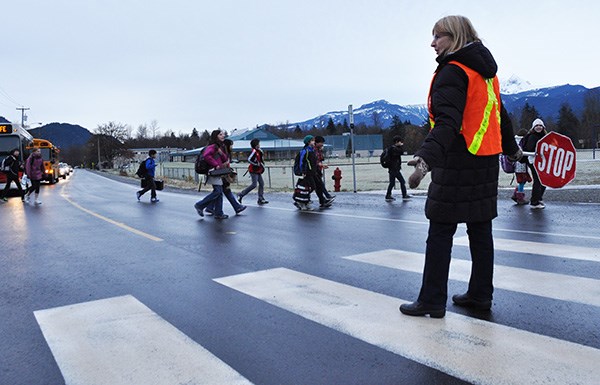If all goes according to plan, more Squamish students will soon be walking and biking to school and reducing harmful emissions in the process.
Council passed a motion at its meeting Tuesday for three Squamish elementary schools to begin Hub for Active School Travel (HASTe) programs this fall followed by three schools in the fall of 2016.
The first three schools has yet to be selected.
The program, which is in or setting up in 10 communities around B.C., aims to get young students and their parents out of cars and travelling to school by human-powered means, according to Kerry Hamilton, community program manager for HASTe in Squamish.
The need for the program is reflected in the D- mark that Canada received for the 2014 Active Healthy Kids Canada report card. The study found only 24 per cent of Canadian parents said their children aged 5 to 17 always walk or wheel to and from school; 62 per cent said their kids are always driven.
Fifty-eight per cent of parents said they walked to school when they were children.
Step one of implementing the program is collecting baseline data, Hamilton said, finding out what obstacles there are to students walking or biking to school. Surveys are taken in classrooms to find out how students got to school each day. Another survey is sent home to find out what the reasons are for driving to and from school, and if the family members walk or cycle to school, what route they travel.
Some misconceptions prevent students or their parents from opting to walk or bike, and those can be tackled, Hamilton said. One is stranger danger – the exaggerated fear of a child being kidnapped on the way to or from school. There is a one-in-4 million chance of a child being abducted while there is a one-in-four chance of a child being obese, according to HASTe documents.
Step two involves bringing together all the stakeholders to the schools to discuss concerns highlighted from the collection of information.
“So the planners, the engineers, the school board, the health authority, the policing, bylaws, we bring everyone out to the schools and we talk about those concerns,” Hamilton said.
Step three, likely undertaken in the spring, is devising an action plan for each school.
“Those actions really consist of infrastructure actions and culture-behaviour change actions,” she said.
An example of an action could be organizing a bike pool for which students and a facilitator get together to go over the routes to school.
The HASTe program started in 2009 as a way to combat two interconnected problems.
“Our obesity rates for children are going up and this realization that traffic congestion around schools is a complete nightmare,” Hamilton said.
A local facilitator for the program will be hired in the coming weeks.
Squamish council set aside $60,000 for the program in this year’s budget.
“It is so important that the schools and the students and the teachers are all buying into the potential of this program,” said Mayor Patricia Heintzman. “That is really key to its success.” For more on the program go to www.hastebc.org.




